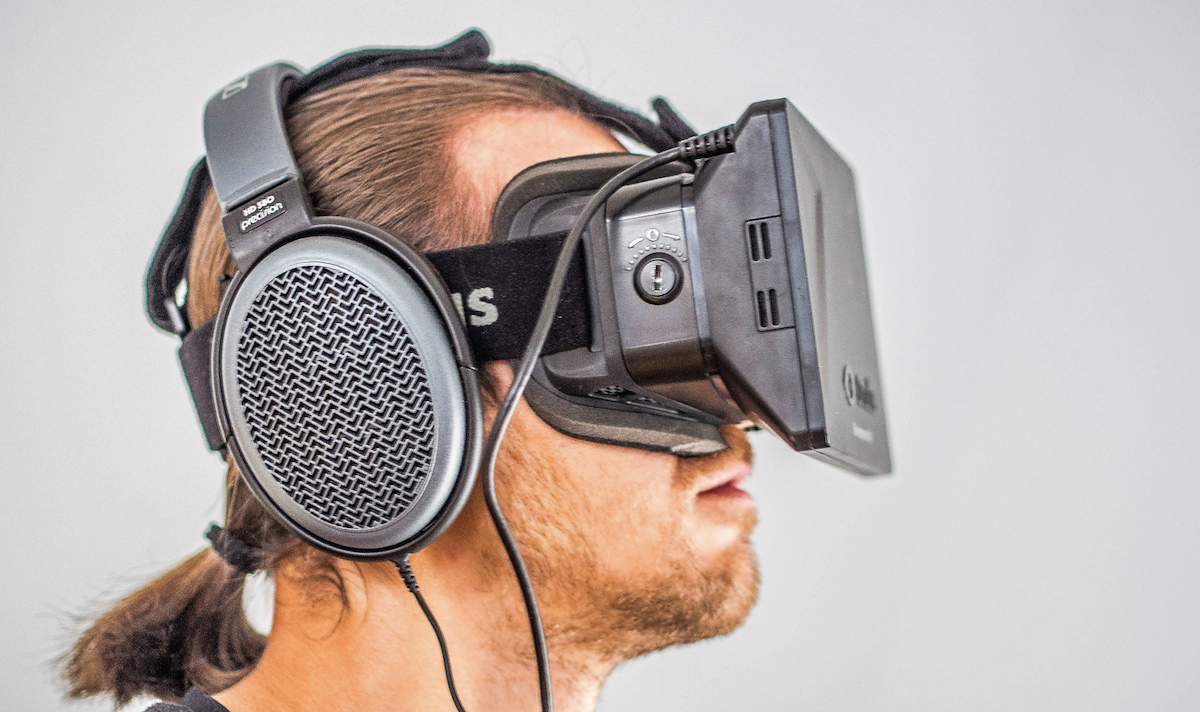By Gil Shefler October 13, 2016

(The Oculus Rift virtual reality headset ©Sergey Galyonkin)
Virtual reality journalism—a medium whose 360-degree video approach immerses users in stories like no other—is rapidly emerging. According to some estimates, the market will be worth $4 billion and capture over 150 million viewers by 2018.
News organizations like the Wall Street Journal, New York Times, and The Associated Press are scrambling to figure out how to best apply the technology to their storytelling.
Of all the potential areas of coverage, business journalism probably presents the biggest challenge for VR. Visual storytellers have long struggled to cover business stories, where the backdrop is often bland offices and bank exteriors and the emphasis is on numbers and figures.
“With traditional video, it’s always been a bigger challenge to tell financial stories, and VR is a continuum down that road,” said Lisa R. Cohen, director of duPont Awards and an adjunct professor at Columbia University. “That’s why with regular videos covering business you have lots of graphics, wiz bang images and people trying to relay the information in a very narrative, folksy way.”
Cohen, who covers VR in her video storytelling class at Columbia University, offered a few tips for beginners:
1) Make Extra Room for Error: “If you’re thinking of dabbling with this medium, give yourself at least ten times more time than you would using another,” Cohen said. During her experimentations with VR she discovered ideas that seemed good on the drawing board didn’t always work in practice, requiring reshoots and extra editing.
2) Focus on Points of Action: Given the 360-degree orientation, viewers can become distracted and miss important details. Cohen said one way to prevent this is to tie visuals closely to the story, making sure the viewers’ gaze is pointed in the right direction. Using a landscape as “wallpaper” won’t do.
3) Keep a Checklist: Using the technology itself is still a challenge. Stitching—a still mostly manual process whereby separate video images are pieced together to create the 360-degree view—is laborious and time consuming. Keeping track of the settings on all of the many cameras can be taxing. If you lose one setting or forget to turn one camera off or on, the shot is lost.
4) Consider Animation: Cohen suspects computer-generated graphics might lend themselves better to certain kinds of business stories, particularly more abstract ones, than video images.
Animating Reality
Indeed, much of the excitement about VR for business journalism revolves around computer-generated imagery.
Roger Kenny made a name for himself at the Wall Street Journal a few years ago when he created a computer game in which former Chairman of the Federal Reserve Ben Bernanke flies a jetpack fueled by lowering interest rates — keeping himself and, by analogy, the economy, from crashing.
“You can have an essay that describes these dynamics and how they relate to each other,” said Kenny who has a background in both editorial and engineering. “But for the average person, if they can press a button and these things are all moving, you can deliver them a natural sensation that’s much more intuitive.”
Kenny is now a member of the newspaper’s Innovations Team, a group of journalists and developers trying to identify applications for virtual reality in business journalism. They sit around a large, shared desk on the 7th floor of the News Corporation building, throwing ideas around and occasionally pulling out gadgets like Microsoft’s Hololens—an augmented reality device currently only available to developers for $3,000 a unit.

Rollercoaster, Tokyo, Japan. ©Nesnad, Creative Commons
The WSJ’s first VR experience only launched last April. The pilot project reimagined the highs and lows of Nasdaq over the past 10 years as a rollercoaster ride. At key points, the rollercoaster pauses to provide viewers with information about how and why the market reacted the way it did.
“Just being up there on a narrow path and looking down below before you crash down to the lowest point, you really feel unstable,” said Kenny.
A lot of thinking went into the details. For instance, the rollercoaster’s rails narrow as the index’s P/E ratio, or price to earnings ratio, soars—bumping up the viewer’s sense of vertigo as stocks become overpriced.
Because too few are familiar with or have access to VR devices like the Samsung Gear VR or Oculus Rift, the rollercoaster experience was designed to work across all platforms including regular desktops and mobile phones, Kenny said.
Over the coming weeks, and with the expected release of Google’s Daydream in November, the Internet giant’s first foray into VR, WSJ will launch new content that it is not at liberty to discuss yet. Either way, the company is investing a lot of resources into capturing what it expects to be a massive VR market.
“Our aim is to get [VR] out of the box,” said Himesh Patel, the Innovation Team’s creative director. “There’s no [story] structure that’s been proven to work within VR yet. Within the next year or six months people will have a better understanding of that.”
The Limits of VR Video
Although computer-generated graphics may dominate business VR stories, there are plenty of potential uses for other VR formats, such as regular 360-degree videos or 3-D renderings of virtual spaces, says Paul Cheung, director of interactive news for the Associated Press.
“When we think about business, we have a tendency to think about it in terms of market and finance,” said Cheung, who leads the newswire’s 360 video /VR team. “It involves, however, so much personal finance and nuts and bolts kind of things. Imagine you do a 360-video technical explainer about what goes on inside hacking a phone. There are so many different ways you can tell this story in VR.”
So far, his team has created 18 VR/360 video/3-D experiences in total. Three of those stories were business stories: A story on a new port in Rio de Janeiro, a piece on the world’s largest automated package processing facility and a look at luxury travel in an era of wage stagnation.

Queen Mary 2 ocean liner. © Trondheim Havn
With the click of a button, viewers of that last story can explore a $12,000 luxury suite on Singapore Airlines, a $20,000 duplex on the Queen Mary 2 ocean liner or a $50,000 penthouse at the Four Seasons, the kinds of spaces they might not otherwise ever have access to.
“I think making business stories might not be as obvious,” said Cheung, “it just takes a little bit more of creativity.”
Will VR catch on with viewers? A lot of people are betting on it, but this isn’t the first time VR has been tried. During the 1990s, there was a brief VR fad that peaked with the appearance of products like Nintendo’s Virtual Boy. Poor sales proved so devastating to the industry that VR lay dormant for the next two decades. But Virtual Boy was exclusively for gaming and the technology was not what it is today. Cheung said we were unlikely to see a repeat of that story.
“I think this is staying because it’s very mobile focused,” he said. “From VR to Augmented Reality and Mixed Reality, this is the beginning of a new industry, and a lot of journalists are starting to understand what we can do with it.
This entry was posted on Thursday, October 13th, 2016 at 7:00 am. It is filed under Featured, Skills and Tradecraft. You can follow any responses to this entry through the RSS 2.0 feed.
Comments are closed.
